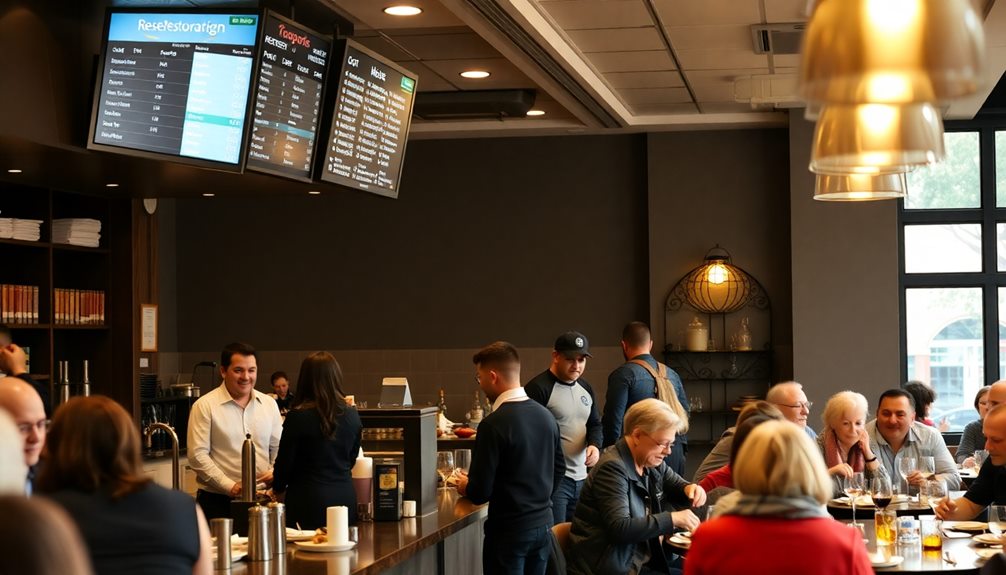Restaurants manage food waste by implementing effective strategies that reduce overproduction and repurpose surplus. They use inventory management systems to track food needs accurately, minimizing waste caused by excess. Regular audits help identify specific waste sources, allowing for targeted improvements. Many restaurants donate surplus food to nonprofits, helping those in need while cutting down on waste. They also engage consumers by offering smaller portion sizes and encouraging take-home options. This multi-faceted approach not only combats waste but also fosters community support and sustainability. Discover more about these practices and how they can make a difference.
Key Takeaways
- Restaurants implement inventory management systems to track food needs and minimize overproduction, reducing waste and associated costs.
- Surplus food is donated to nonprofits, supported by the Bill Emerson Good Samaritan Food Donation Act, ensuring safety and liability protection.
- Food matching platforms help restaurants sell excess meals at discounted prices, effectively managing surplus inventory and enhancing sustainability efforts.
- Regular waste audits and tracking systems analyze food waste sources, helping restaurants set benchmarks and improve inventory management.
- Engaging consumers through smaller portions and awareness campaigns fosters a culture of sustainability and reduces food waste in dining experiences.
Importance of Food Waste Reduction
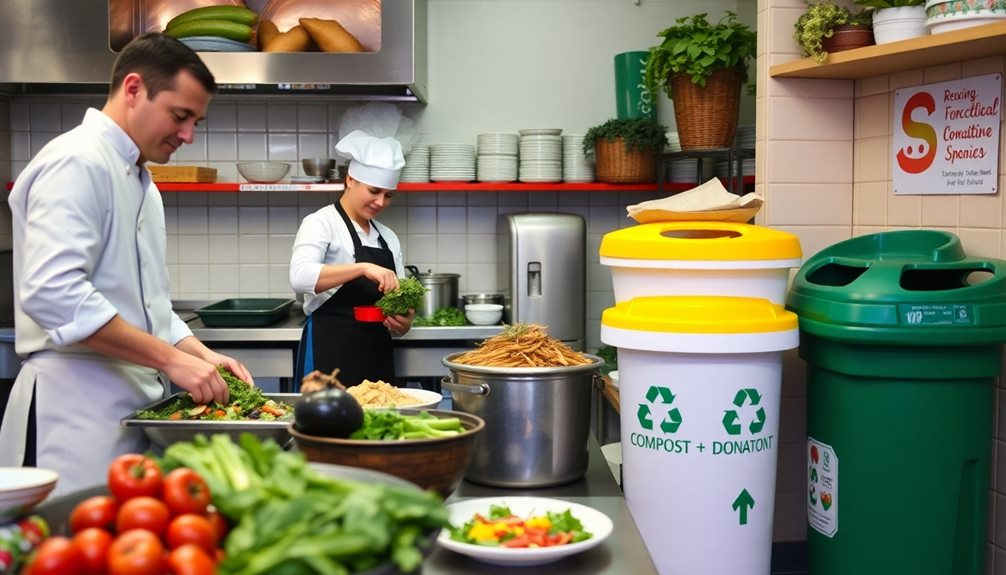
The restaurant industry's impact on food waste is staggering, with around 30-40% of the food supply in the U.S. going to waste each year. This immense waste equates to approximately 11.4 million tons annually, highlighting the critical need for effective food waste reduction strategies in restaurants.
Implementing these strategies not only helps you reduce food waste but also addresses significant financial losses, as the average restaurant throws away about 4-10% of its food inventory.
Moreover, wasted food contributes to 8-10% of global greenhouse gas emissions, making it imperative for restaurants to adopt sustainable practices. By focusing on food recovery and improving operational efficiency, you can lessen your environmental footprint while promoting sustainability.
Reducing food waste also combats food insecurity by redirecting surplus food to those in need, creating a positive community impact.
Ultimately, embracing food waste reduction isn't just about saving money; it's about fostering a responsible and sustainable restaurant industry. By prioritizing these strategies, you can contribute to a healthier planet and a more equitable food system, ensuring that your restaurant plays its part in creating a better future.
Strategies for Waste Prevention
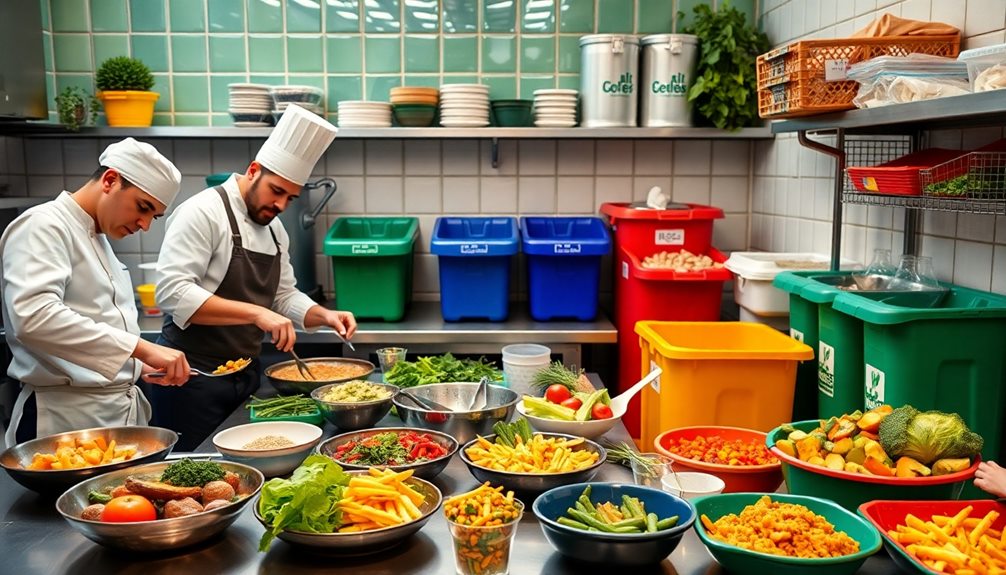
Implementing effective strategies for waste prevention can greatly reduce food waste in your restaurant. Start with robust inventory management systems that accurately track your food needs. This helps minimize overproduction and excess inventory, which are key contributors to waste.
Establish clear guidelines for food storage and handling to guarantee ingredients are used before they spoil. Utilizing predictive order management systems can optimize food production based on historical data and trends, reducing the likelihood of over-ordering.
Regularly conducting food waste audits will identify the types and amounts of waste generated, enabling you to adjust your practices and potentially recover 1% to 6% in lost sales.
Don't underestimate the importance of staff training. Educating your team on waste tracking and management procedures fosters a culture of waste reduction, enhancing efficiency and accountability within your restaurant.
Encourage your staff to be proactive in identifying potential waste areas and provide them with the tools they need to help you reduce food waste effectively. By adopting these strategies, you're not just saving money; you're also making a positive impact on the environment.
Surplus Food Recovery Options

When it comes to managing surplus food, you've got some effective options at your fingertips.
Collaborating with nonprofits or using food matching platforms can help you donate excess food while boosting your bottom line.
Just remember to follow safety and compliance guidelines to guarantee the food remains safe for those in need.
Donation to Nonprofits
Collaborating with nonprofits can greatly enhance your restaurant's efforts to donate surplus food, reducing waste while supporting those in need in your community. Engaging in food donation not only helps alleviate hunger but also contributes to the significant issue of food waste in the restaurant sector.
By donating surplus food, you can play a crucial role in food recovery, tackling the estimated 11.4 million tons of food wasted annually in the U.S.
The Bill Emerson Good Samaritan Food Donation Act provides liability protection, encouraging restaurants like yours to participate in this essential effort. When you're collaborating with nonprofits, make sure you adhere to food safety guidelines to maintain the quality and safety of the donated food. This compliance will protect both your restaurant and the recipients.
Additionally, organizations and apps such as Too Good To Go can streamline the process, helping you efficiently distribute surplus food to those who need it most.
Food Matching Platforms
Food matching platforms offer a practical solution for restaurants looking to tackle surplus food while benefiting consumers. By using platforms like Too Good To Go, you can sell excess meals at discounted prices, enabling you to reduce food waste and provide affordable options for your community.
These technology-driven platforms streamline the process of surplus food recovery, ensuring you meet food safety regulations while efficiently managing excess inventory. Additionally, engaging in sustainable practices can enhance your restaurant's appeal, as customers increasingly seek out businesses that prioritize responsible environmental impacts, including Louisiana alimony laws in their operational strategies.
Collaborating with food donation matching organizations also enhances your community support. You can donate surplus food directly to local nonprofits and food banks, helping those in need and reinforcing your commitment to sustainable practices.
Studies show that up to 40% of surplus food could be redirected, considerably decreasing waste while benefiting your neighborhood.
Participating in food matching platforms not only helps you reduce food waste but also enhances your restaurant's reputation. Customers increasingly prioritize sustainability, and your involvement in these initiatives can attract a loyal clientele who values your efforts.
Ultimately, food matching platforms represent a win-win solution, allowing you to support your community and maintain a positive image while addressing surplus food challenges effectively.
Safety and Compliance
Maneuvering the complexities of safety and compliance is vital for restaurants engaging in surplus food recovery. By familiarizing yourself and your staff with the Bill Emerson Good Samaritan Food Donation Act, you can guarantee liability protection for food donors. This knowledge empowers you to participate in food donation without fearing legal repercussions.
Compliance with food safety guidelines is integral during the donation process. You'll want to maintain the quality and safety of donated food, guaranteeing it's fit for consumption. Regular staff training on food safety and handling practices fosters a culture of waste reduction and awareness in your restaurant. This creates a knowledgeable team ready to engage in effective surplus food recovery.
Utilizing food donation matching organizations and apps like Too Good To Go can streamline your food distribution efforts, making it easier to connect with consumers and minimize waste.
Additionally, engaging in food recovery programs can greatly cut operational costs. By donating edible food, you can benefit from reduced disposal fees and potential tax incentives for charitable contributions.
Tracking and Measuring Waste
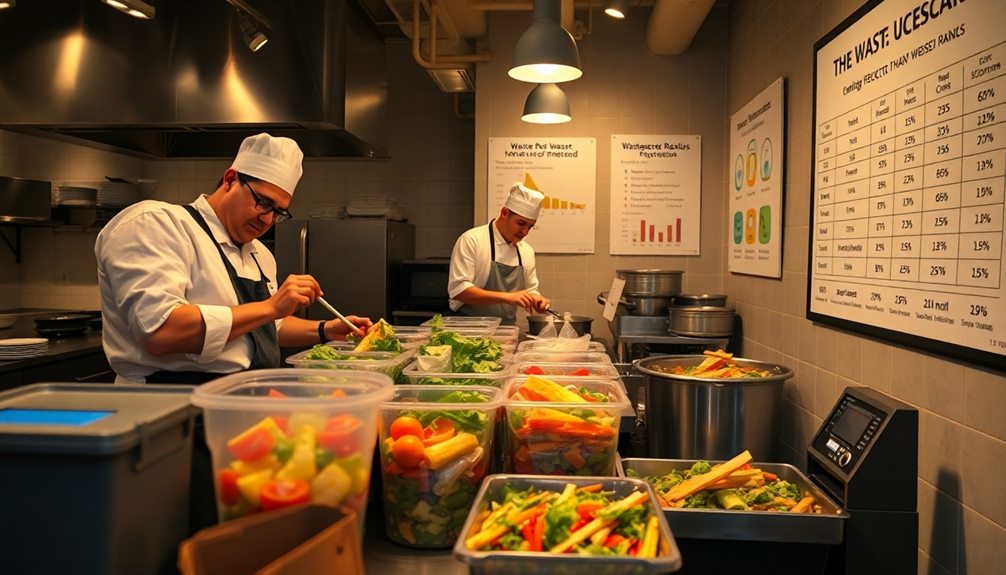
To effectively manage food waste in your restaurant, tracking and measuring it's essential. Start by conducting regular waste audits, which can help you identify specific sources of waste and establish a baseline. By tracking food waste, you can potentially reduce costs by 2% to 6%.
Implementing waste tracking systems allows you to analyze the type, weight, and source of your food scraps, engaging your kitchen staff in this crucial process.
Utilizing data analytics can further enhance your understanding of food waste trends and patterns. This information is invaluable for optimizing your inventory management and minimizing excess food.
With actionable insights from your audits and data analytics, you can set benchmarks for food waste reduction and identify areas needing improvement.
Moreover, reporting waste metrics to your stakeholders promotes accountability and fosters a culture of continuous improvement in your waste management practices.
Inventory Management Techniques
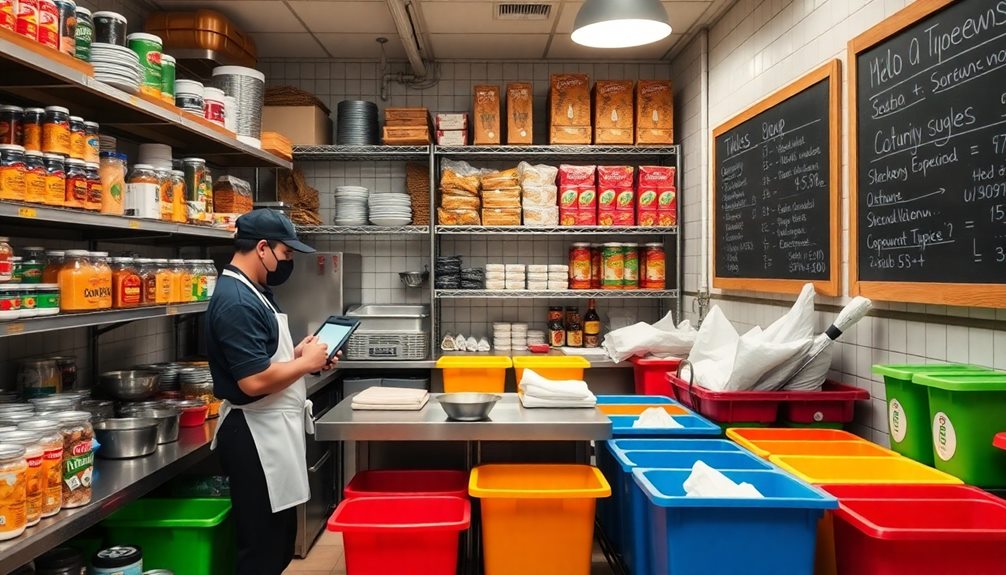
Effective inventory management techniques can drastically cut down on food waste in your restaurant. By accurately tracking food needs and guaranteeing stock levels match demand, you can potentially save 2-6% in costs.
The First In, First Out (FIFO) method is vital; it guarantees that older inventory gets used before newer stock, helping maintain food quality and reduce waste.
Utilizing predictive order management systems allows you to optimize food production based on historical data and trends, preventing overproduction and excess waste. Regular inventory reviews and adjustments to your purchasing practices based on sales data can mitigate the risks of excess inventory, which is a major contributor to food waste.
Conducting food waste audits is another effective strategy. These audits help you identify specific types and amounts of waste, enabling targeted inventory management strategies.
By implementing these techniques, you're not just reducing waste; you're also enhancing profitability. Demand forecasting plays a significant role in this process, making sure you order the right amount of each item, thereby minimizing excess stock.
With these inventory management techniques, you can tackle food waste head-on and boost your restaurant's efficiency.
Engaging Consumers in Solutions
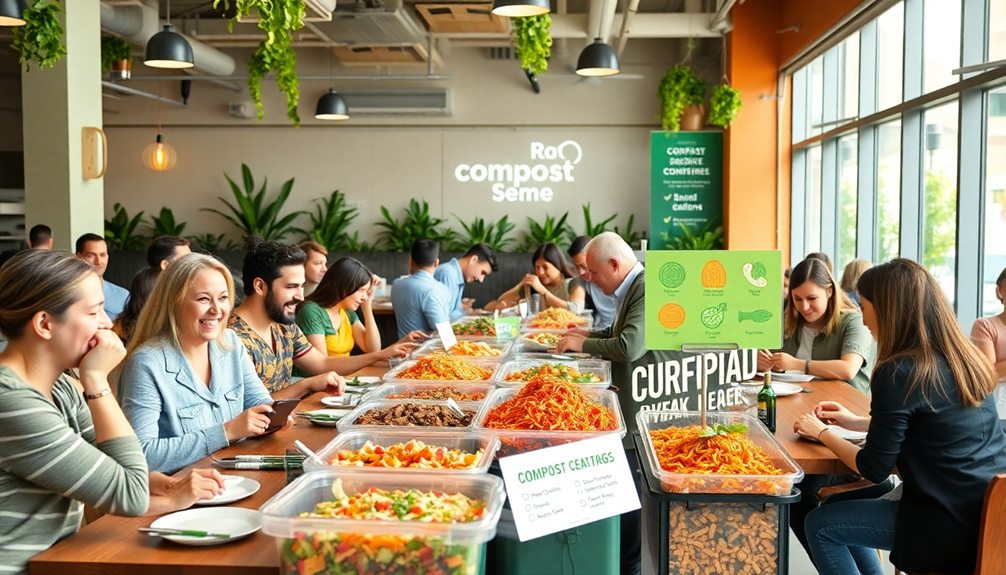
Engaging consumers in food waste reduction is essential for creating a more sustainable dining experience. One effective way to do this is by offering smaller portion sizes. Not only do these options help reduce food waste, but they also cater to the 47% of diners willing to pay more for sustainability-focused meals.
Additionally, implementing "doggy bag" options encourages you to take home leftovers, further minimizing waste.
Raising awareness about food waste issues can foster a culture of meal planning and conscious consumption. With 72% of U.S. diners already aware of the problem, restaurants can educate you on how to plan meals better and make smarter choices.
Social media and outreach campaigns are also powerful tools to engage consumers. When restaurants share their food-saving stories, it inspires you to participate and contribute to food waste reduction efforts.
By joining local food rescue initiatives, you can actively help reduce food waste, as organizations like Move For Hunger facilitate donations of surplus food.
Together, these strategies not only promote sustainability but also empower you to become a part of the solution in the fight against food waste.
Frequently Asked Questions
How Do Restaurants Deal With Leftover Food?
You'll find restaurants tackle leftover food by donating it to local charities, using apps to sell surplus meals cheaply, and improving inventory practices. They also train staff on proper storage and portioning to minimize waste. Additional strategies focus on how restaurants preserve food freshness to reduce spoilage. Many invest in high-quality refrigeration systems and use vacuum-sealing techniques to extend the shelf life of perishable items. By adopting these measures alongside creative waste-reduction practices, restaurants can significantly lower their environmental impact while supporting their communities.
How Can We Control Food Waste in the Food Industry?
You can tackle food waste in the industry by embracing smart inventory practices, training staff effectively, and forecasting demand accurately. By focusing on these strategies, you'll create a more sustainable and efficient food environment.
How Do Restaurants Calculate Food Waste?
To calculate food waste, you'll conduct regular audits, track discarded items' weight, and categorize them. Engaging your staff in daily recording fosters accountability, helping pinpoint waste sources and guiding targeted reduction strategies effectively.
How Is Food Waste Handled?
Handling food waste's like steering a ship through stormy seas. You assess what's left, track what's used, and optimize storage. By donating surplus, you not only reduce waste but also anchor your community in support.
Conclusion
In the quest to cut costs and conserve resources, restaurants can't ignore the importance of managing food waste. By adopting smart strategies and strengthening surplus food recovery, they not only support sustainability but also satisfy savvy consumers. Tracking waste and fine-tuning inventory guarantees efficiency while engaging patrons encourages a collective commitment. Ultimately, through mindful management, restaurants can transform their practices, turning trash into treasure and fostering a future where food waste is minimized and delicious dining is maximized.

